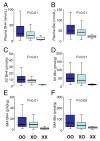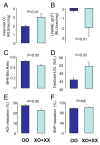GCH1 haplotype determines vascular and plasma biopterin availability in coronary artery disease effects on vascular superoxide production and endothelial function
- PMID: 18598896
- PMCID: PMC2699614
- DOI: 10.1016/j.jacc.2007.12.062
GCH1 haplotype determines vascular and plasma biopterin availability in coronary artery disease effects on vascular superoxide production and endothelial function
Abstract
Objectives: This study sought to determine the effects of endogenous tetrahydrobiopterin (BH4) bioavailability on endothelial nitric oxide synthase (eNOS) coupling, nitric oxide (NO) bioavailability, and vascular superoxide production in patients with coronary artery disease (CAD).
Background: GTP-cyclohydrolase I, encoded by the GCH1 gene, is the rate-limiting enzyme in the biosynthesis of BH4, an eNOS cofactor important for maintaining enzymatic coupling. We examined the associations between haplotypes of the GCH1 gene, GCH1 expression and biopterin levels, and the effects on endothelial function and vascular superoxide production.
Methods: Blood samples and segments of internal mammary arteries and saphenous veins were obtained from patients with CAD undergoing coronary artery bypass grafting (n = 347). The GCH1 haplotypes were defined by 3 polymorphisms: rs8007267G<A, rs3783641A<T, and rs10483639C<G (X haplotype: A, T, G; O haplotype: any other combination). Vascular superoxide (+/- the eNOS inhibitor N(G)-nitro-L-arginine methyl ester [L-NAME]) was measured by lucigenin-enhanced chemiluminescence, whereas the vasorelaxations of saphenous veins to acetylcholine were evaluated ex vivo.
Results: Haplotype frequencies were OO 70.6%, XO 27.4%, and XX 2.0%. The X haplotype was associated with significantly lower vascular GCH1 messenger ribonucleic acid expression and substantial reductions in both plasma and vascular BH4 levels. In X haplotype carriers both vascular superoxide and L-NAME-inhibitable superoxide were significantly increased, and were associated with reduced vasorelaxations to acetylcholine.
Conclusions: GCH1 gene expression, modulated by a particular GCH1 haplotype, is a major determinant of BH4 bioavailability both in plasma and in the vascular wall in patients with CAD. Genetic variation in GCH1 underlies important differences in endogenous BH4 availability and is a determinant of eNOS coupling, vascular redox state, and endothelial function in human vascular disease.
Figures



Comment in
-
Complex trait genetics the role of mechanistic "intermediate phenotypes" and candidate genetic loci.J Am Coll Cardiol. 2008 Jul 8;52(2):166-8. doi: 10.1016/j.jacc.2008.02.080. J Am Coll Cardiol. 2008. PMID: 18598897 Free PMC article. No abstract available.
References
-
- Harrison D, Griendling KK, Landmesser U, Hornig B, Drexler H. Role of oxidative stress in atherosclerosis. Am J Cardiol. 2003;91:7A–11A. - PubMed
-
- Channon KM. Tetrahydrobiopterin: regulator of endothelial nitric oxide synthase in vascular disease. Trends Cardiovasc Med. 2004;14:323–7. - PubMed
-
- Heitzer T, Brockhoff C, Mayer B, et al. Tetrahydrobiopterin improves endothelium-dependent vasodilation in chronic smokers: evidence for a dysfunctional nitric oxide synthase. Circ Res. 2000;86:E36–41. - PubMed
-
- Antoniades C, Shirodaria C, Warrick N, et al. 5-methyl-tetrahydrofolate rapidly improves endothelial function and decreases superoxide production in human vessels: effects on vascular tetrahydrobiopterin availability and eNOS coupling. Circulation. 2006;114:1193–201. - PubMed
Publication types
MeSH terms
Substances
Grants and funding
LinkOut - more resources
Full Text Sources
Other Literature Sources
Medical
Miscellaneous

